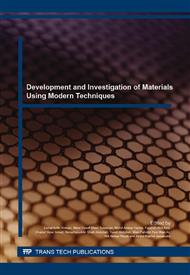p.156
p.160
p.165
p.170
p.175
p.180
p.185
p.191
p.197
Effect of Bath Temperature on Surface Properties of Anodised Titanium for Biomedical Application
Abstract:
Anodic oxidation is an electrochemical method to deposit ceramic coatings on the metals substrate to improve the bioactivity. This study aims to investigate the effect of bath temperature on the surface properties of anodised titanium. High-purity titanium foil was modified by anodising in mixture of β-glycerophosphate disodium salt pentahydrate (β-GP) and calcium acetate monohydrate (CA). The experiments were carried out at 350 V, 30 mA.cm-2 for 10 minutes at different bath temperature (4-100 °C). Field emission scanning electron microscopy (FESEM), glancing angle X-ray diffractometer (GAXRD) and goniometer were used to characterise the surface morphology, mineralogy and wettability of anodised titanium, respectively. The results showed that porosity and crystallinity of surface decreased as increasing of bath temperature. Interestedly, the α-tricalcium phosphate (α-TCP) was deposited on the samples which anodisation at higher bath temperature (≥ 60 °C) and resulted high hydrophilicity behaviour even the surface was found relatively smooth.
Info:
Periodical:
Pages:
175-179
Citation:
Online since:
January 2016
Price:
Сopyright:
© 2016 Trans Tech Publications Ltd. All Rights Reserved
Share:
Citation:


